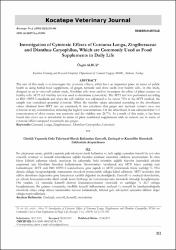Günlük yaşamda gıda takviyesi olarak kullanılan zencefil, zerdeçal ve karanfilin sitotoksik etkilerinin araştırılması
Citation
Albuz, Ö. (2019). Günlük Yaşamda Gıda Takviyesi Olarak Kullanılan Zencefil, Zerdeçal ve Karanfilin Sitotoksik Etkilerinin Araştırılması . Kocatepe Veterinary Journal , 12 (3) , 351-356 . DOI: 10.30607/kvj.593514Abstract
Bu çalışmanın amacı, günlük yaşamda gıda takviyesi olarak kullanılan ve halk sağlığı açısından önemli bir yeri olan
zencefil, zerdeçal ve karanfil tohumlarının sağlıklı hücreler üzerinde sitotoksik etkilerini araştırmaktır. İn vitro
hücre kültürü çalışması olarak tasarlanan bu çalışmada, bitki özlerinin sağlıklı hücreler üzerindeki etkisini
araştırmak için fibroblast hücreleri kullanılmıştır. Sitotoksisiteyi belirlemek için MTT hücre canlılığı testi
kullanılmıştır. MTT testi ISO 10993-5 standartlarına göre yapıldı ve MTT yönteminde hücre canlılığı % 70'in
altında olduğu hesaplandığında, numunenin sitotoksik potansiyelde olduğu kabul edilmiştir. MTT testinden elde
edilen absorbans değerlerine göre hesaplanan canlılık değerleri incelendiğinde; Zencefil ve zerdeçal ekstrelerinin,
en yüksek konsantrasyonlar dahil olmak üzere herhangi bir konsantrasyonda sitotoksik olmadığı hesaplanmıştır.
Öte yandan, 1:2 oranında karanfil ekstresi konsantrasyonunun sitotoksik ve canlılığın % 26.7 olduğu
hesaplanmıştır. Bu çalışma sonucunda, özellikle karanfil kullanımının zerdeçal ve zencefil ile karşılaştırıldığında
sitotoksik etkiye sahip olması bakımından mevcut kullanımıyla, bitkisel gıda takviyeleri açısından dikkate değer
olduğu tespit edilmiştir. The aim of this study is to investigate the cytotoxic effects, which have an important place ,in terms of public
health as using herbal food supplement, of ginger, turmeric and clove seeds over healthy cells. In this study,
designed as an in vitro cell culture study, fibroblast cells were used to investigate the effect of plant extracts on
healthy cells. MTT cell viability test was used to determine cytotoxicity. The MTT test was performed according
to ISO 10993-5 standards and when the cell viability was calculated to be below 70% in the MTT method, the
sample was considered potential cytotoxic. When the viability values calculated according to the absorbance
values obtained from MTT test are examined; It was calculated that ginger and turmeric extracts were not
cytotoxic at any concentration, including the highest concentrations. On the other hand, it was calculated that 1: 2
concentration of clove extract was cytotoxic and the viability was 26.7%. As a result of this study, it has been
found that clove use is remarkable in terms of plant nutritional supplements with its current use in terms of
cytotoxic effect compared to turmeric and ginger
Source
Kocatepe Veteriner DergisiVolume
12Issue
3URI
https://dergipark.org.tr/tr/pub/kvj/issue/45621/593514https://doi.org/10.30607/kvj.593514
https://hdl.handle.net/11630/9209
Collections
- Cilt 12 : Sayı 3 [22]



















